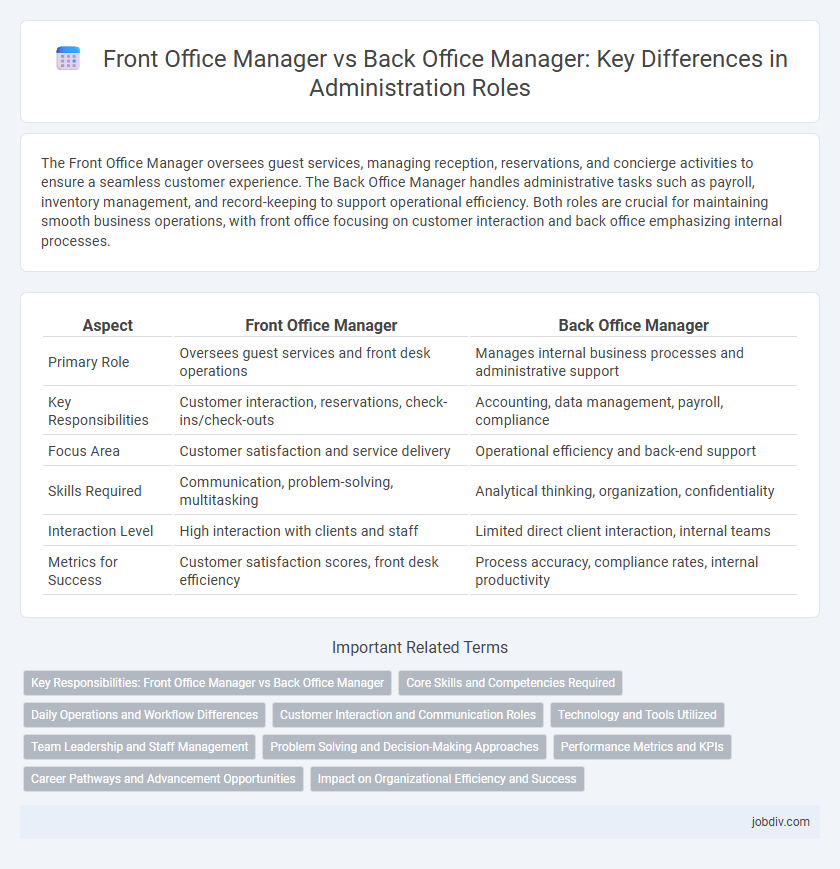The Front Office Manager oversees guest services, managing reception, reservations, and concierge activities to ensure a seamless customer experience. The Back Office Manager handles administrative tasks such as payroll, inventory management, and record-keeping to support operational efficiency. Both roles are crucial for maintaining smooth business operations, with front office focusing on customer interaction and back office emphasizing internal processes.
Table of Comparison
| Aspect | Front Office Manager | Back Office Manager |
|---|---|---|
| Primary Role | Oversees guest services and front desk operations | Manages internal business processes and administrative support |
| Key Responsibilities | Customer interaction, reservations, check-ins/check-outs | Accounting, data management, payroll, compliance |
| Focus Area | Customer satisfaction and service delivery | Operational efficiency and back-end support |
| Skills Required | Communication, problem-solving, multitasking | Analytical thinking, organization, confidentiality |
| Interaction Level | High interaction with clients and staff | Limited direct client interaction, internal teams |
| Metrics for Success | Customer satisfaction scores, front desk efficiency | Process accuracy, compliance rates, internal productivity |
Key Responsibilities: Front Office Manager vs Back Office Manager
A Front Office Manager oversees guest services, manages reception staff, and ensures efficient check-in/check-out processes to enhance customer experience in hospitality or corporate settings. A Back Office Manager is responsible for administrative functions such as payroll, record keeping, compliance, and data management that support the organization's operational infrastructure. Both roles require leadership skills but focus on distinct operational areas: front-office for client-facing interactions, back-office for internal process optimization.
Core Skills and Competencies Required
Front Office Managers require strong customer service skills, effective communication, and the ability to manage guest relations and front desk operations efficiently. Back Office Managers need expertise in data management, financial analysis, and process optimization to ensure smooth administrative and operational support. Both roles demand leadership, problem-solving abilities, and proficiency in relevant software systems to enhance organizational workflow.
Daily Operations and Workflow Differences
Front Office Managers oversee customer interactions, reservations, and immediate service issues, ensuring smooth guest experiences and efficient communication with other departments. Back Office Managers handle administrative tasks, financial record-keeping, and internal process management, focusing on operational accuracy and support functions behind the scenes. The daily workflow of Front Office Managers is client-facing and responsive, while Back Office Managers engage in data analysis and regulatory compliance to maintain organizational stability.
Customer Interaction and Communication Roles
Front Office Managers directly oversee customer interaction, managing reception, inquiries, and real-time communication to enhance client satisfaction and service efficiency. Back Office Managers focus on internal communication workflows, data management, and support functions that do not involve face-to-face customer contact but ensure operational continuity. Effective coordination between Front Office and Back Office Managers optimizes overall organizational communication and customer experience.
Technology and Tools Utilized
Front Office Managers utilize customer relationship management (CRM) software, point of sale (POS) systems, and reservation management tools to streamline guest interactions and sales processes. Back Office Managers rely heavily on enterprise resource planning (ERP) systems, accounting software, and inventory management tools to ensure efficient internal operations and accurate financial reporting. Both roles leverage cloud-based platforms and data analytics to enhance productivity and decision-making within administrative functions.
Team Leadership and Staff Management
Front Office Managers specialize in team leadership by directly overseeing customer-facing staff, ensuring high levels of guest satisfaction and frontline operational efficiency, while Back Office Managers focus on managing support teams that handle administrative functions such as finance, HR, and IT. Front Office Managers prioritize real-time problem solving and staff motivation to maintain smooth customer interactions, whereas Back Office Managers emphasize process optimization and interdepartmental coordination to support organizational goals. Both roles require strong leadership skills, but Front Office Managers lead dynamic, service-oriented teams, and Back Office Managers manage analytical and operational teams behind the scenes.
Problem Solving and Decision-Making Approaches
Front Office Managers prioritize real-time problem solving and dynamic decision-making to enhance customer experience and operational efficiency. Back Office Managers implement systematic, data-driven decision-making processes to optimize internal workflows and support organizational stability. Both roles require strategic thinking, but Front Office Managers emphasize immediate solution deployment, while Back Office Managers focus on long-term process improvements.
Performance Metrics and KPIs
Front Office Managers are evaluated using performance metrics such as customer satisfaction scores, average handling time, and revenue generated through direct client interactions, reflecting their impact on service quality and sales. Back Office Managers focus on operational KPIs like process efficiency, error rates, and turnaround time for administrative tasks to ensure smooth internal workflows. Comparing these roles highlights the Front Office Manager's influence on external customer experience versus the Back Office Manager's role in optimizing internal business processes.
Career Pathways and Advancement Opportunities
Front Office Managers often advance through roles in guest services or hospitality management, gaining skills in customer interaction and operational oversight that lead to senior management positions. Back Office Managers typically progress via finance, HR, or IT departments, acquiring expertise in process optimization and administrative leadership essential for executive roles. Career pathways in both areas emphasize strategic decision-making, with Front Office focusing on client-facing leadership and Back Office on organizational efficiency.
Impact on Organizational Efficiency and Success
A Front Office Manager directly influences organizational efficiency by overseeing customer-facing operations, enhancing client satisfaction, and driving revenue through service quality. In contrast, a Back Office Manager optimizes internal processes, streamlining administrative functions and ensuring accurate data management to support decision-making. Both roles are critical; the Front Office Manager boosts external perceptions and sales, while the Back Office Manager ensures operational stability and productivity, collectively contributing to organizational success.
Front Office Manager vs Back Office Manager Infographic

 jobdiv.com
jobdiv.com